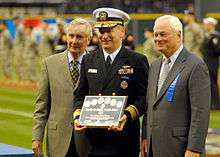Howard Lincoln
| Howard Lincoln | |
|---|---|
 Lincoln (left) in 2007 | |
| Born |
February 14, 1940 Oakland, California, U.S. |
| Nationality | American |
| Alma mater | University of California, Berkeley |
| Known for | Former chairman of Nintendo of America, current CEO of Seattle Mariners |
|
Military career | |
| Allegiance |
|
| Service/branch |
|
| Years of service | 1966-1970 |
| Rank |
|
Howard Charles Lincoln (born February 14, 1940) is an American lawyer and businessman, known primarily for being the former chairman of Nintendo of America and the current Chairman and Chief Executive Officer of the Seattle Mariners baseball team, representing absentee majority owner Hiroshi Yamauchi until Yamauchi died on September 19, 2013.
Biography
Born in Oakland, California, Lincoln was an active Boy Scout. As a thirteen-year-old boy, he posed for the famous Norman Rockwell painting The Scoutmaster, which was published in a calendar in 1956.[1] In the painting, young Lincoln is on the immediate right of the campfire. Lincoln eventually attained the rank of Eagle Scout and received a Distinguished Eagle Scout Award.
Lincoln matriculated in 1957 at the University of California, Berkeley, where he earned his BA in political science in 1962 and his law degree from Berkeley Law in 1965. From 1966 to 1970, he served as a Naval lieutenant within the Judge Advocate General's Corps. He then worked in private practice as an attorney in Seattle, Washington. There he did legal work in 1981 for Nintendo, culminating in the legal case Universal City Studios, Inc. v. Nintendo Co., Ltd., in which Universal City Studios had sued Nintendo claiming that the video game Donkey Kong infringed upon Universal City Studio's rights to King Kong. Lincoln hired John Kirby to represent Nintendo in the courtroom. Nintendo won the case, as well as successive court appeals.
Lincoln joined Nintendo in 1983, as its Senior Vice President and General Counsel. He and Minoru Arakawa were instrumental in rebuilding the North American video game industry (after the crash of 1983) with their highly successful marketing of the Nintendo Entertainment System.[2] In 1994, he was appointed its chairman.
Lincoln's tenure as CEO of the Seattle Mariners has seen both success and controversy. Lincoln was considered instrumental, along with former Senator Slade Gorton, in preserving the team's location in Seattle and negotiating with the city for a new stadium, Safeco Field. His stewardship has seen the team's first post-season appearances, in 1995, 1997, 2000, and 2001, as well as the aggressive expansion of the Mariners into the Japanese market, most noticeably through the acquisition of Japanese superstar Ichiro Suzuki. However, Lincoln is also held responsible by many for the team's stagnation and decline following 2001. His inability to retain successful field managers and general managers like Lou Piniella and Pat Gillick, carte-blanche attitude towards superstar players, contentious relationship with local media, and pattern of questionable hiring decisions have led to increasing calls within the fanbase for Lincoln to assume a less-active administrative role.
In addition to Lincoln's business achievements, he is an active philanthropist. He has served as campaign chair for United Way of King County and the Chief Seattle Council of the Boy Scouts of America. He is also a trustee of Western Washington University.
References
- ↑ "The Scoutmaster by Norman Rockwell". Oakland Area Council. Retrieved November 22, 2013.
- ↑ "75 Power Players". Next Generation. Imagine Media (11): 58. November 1995.
In 1985 when Nintendo entered the US home videogame market, there was no home videogame market, just the spectacular remnants of an industry that left everyone wary. With Arakawa and Lincoln at the helm and the odds stacked against them, Nintendo of America brilliantly laid the foundations for the sprawling, multifaceted beast that now likes to be known as the interactive entertainment business.